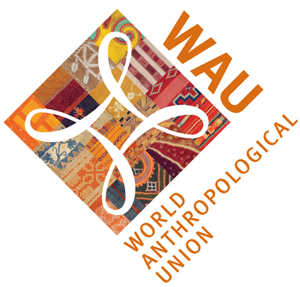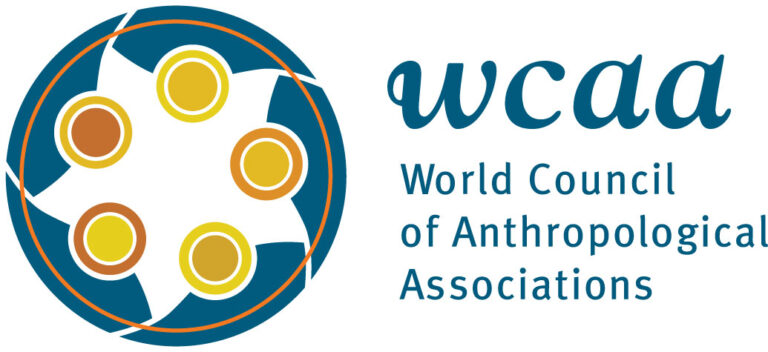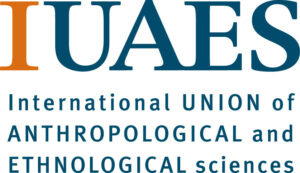
Kimari, Wangui. 2021. “’Under construction’: everyday anxieties and the proliferating social meanings of China in Kenya”. Africa: The Journal of the International African Institute 91(1): 135-152.
Much has been said about the presence of China in Africa over the last fifteen years, with, for the most part, these discussions affirming either a ‘for’ or ‘against’ position. Working from a micro-level perspective, this ethnographic article looks at how the everyday associations of ‘China’ and ‘the Chinese’ in Kenya are increasing, engendering expansive signifiers that proliferate as Kenya's relationship with China deepens. Although I anchor this argument in the local discursive practices that shape the proposed Jomo Kenyatta International Airport (JKIA)–Westlands expressway, I trace how references to China and the Chinese expand beyond construction to take up social meanings that are continuously being assembled. Although the referents may seem unrelated in their diversity, I argue that they index wider local anxieties that de-centre China and re-centre the Kenyan government in practices that place the burdens of ‘development’ on the country's already burdened citizens.
On a beaucoup dit sur la présence de la Chine en Afrique ces quinze dernières années, avec des discussions qui, pour la plupart, affirment une position « pour » ou « contre ». Se plaçant dans une perspective au niveau micro, cet article ethnographique examine l'augmentation des associations courantes de « la Chine » et « les Chinois » au Kenya, engendrant des signifiants expansifs qui prolifèrent tandis que la relation entre le Kenya et la Chine s'intensifie. Bien que le point d'ancrage de cet argument soit les pratiques discursives locales autour du projet de voie rapide entre l'aéroport international Jomo Kenyatta (JKIA) et les Westlands, l'auteur décrit comment les références à la Chine et aux Chinois dépassent la construction elle-même pour prendre des sens sociaux qui se forment continuellement. Malgré l'absence apparente de lien entre les référents dans leur diversité, l'auteur soutient qu'ils sont révélateurs d'anxiétés locales plus larges qui décentrent la Chine et recentrent le gouvernement kényan au cœur de pratiques qui font peser le poids du « développement » sur les épaules des citoyens du pays, déjà accablés.
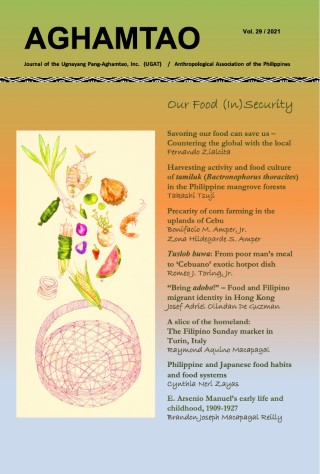
Zialcita, Fernando N.. 2021. “SAVORING OUR FOOD CAN SAVE US – COUNTERING THE GLOBAL WITH THE LOCAL”. Aghamtao 29: 1-23.
Protecting biodiversity could be one way of combatting climate change and creating sustainable employment in the countryside. This strategy can become more palpable if protection is accorded to specific ‘terroirs’ (kapookan) in the Philippines whose products are unique because they result from the interplay between an ecosystem and a cultural tradition. Internationally, both in Europe and Asia, the labelling system called “Geographic Indications” is being used to protect such localities and their products. The essay looks into how these two concepts, “terroir” and “Geographical Indications” could help protect biodiversity and the rural sector in the Philippines. On the one hand, it shows how issues raised by the implementation of the two concepts are meaningful to anthropology. On the other hand, it shows how anthropology could contribute to broadening and deepening these concepts. Because anthropology examines the interaction between communities and their ecosystems, it can locate and define particular terroirs. Moreover, because anthropology tries to interpret objects in their concrete particularity, it can highlight why a particular product is unique both nationally and internationally. Finally, recent anthropology has become more sensitive to the impact of outside forces on the environment. Sadly, international forces are intervening in the implementation of a meaningful version of Geographical Indications.
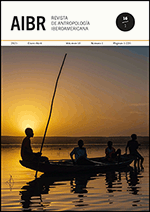
Cuevas, Lydia Rodríguez. 2021. “Los lenguajes del pensamiento (The Languages of the Mind)”. AIBR, Revista de Antropología Iberoamericana 16(1): 61-87.
La relatividad lingüística implica que la presencia o ausencia de distintas categorías gramaticales, así como distintos estilos discursivos, pueden influir en cómo percibimos y experimentamos el mundo que nos rodea. Los mayas choles de Chiapas hablan una lengua que no tiene tiempos verbales, y que utiliza el aspecto gramatical para expresar nociones temporales. Este artículo explora el efecto que la ausencia de tiempos verbales puede tener en la percepción de imágenes secuenciales. En este estudio se presentaron una serie de estímulos visuales a varios hablantes monolingües choles, que consistían en distintos tipos de imágenes secuenciales que los hablantes tenían que describir. Se les mostraron una historia larga a través de múltiples secuencias de imágenes, y varias historias breves compuestas por un mínimo de dos y un máximo de cinco imágenes secuenciales. Ninguna de las narraciones que los choles hicieron de la historia larga o de las historias cortas poseían una lógica secuencial cronológica, y todas las imágenes secuenciales fueron descritas en términos no secuenciales por los hablantes choles. En línea con la hipótesis de relatividad lingüística, en el artículo se plantea que este curioso efecto discursivo puede estar causado por la ausencia de tiempos verbales en la lengua chol.
Linguistic relativity, rightly understood, implies that the presence or absence of certain grammatical categories and discursive styles can influence how we perceive and experience the world around us. In this study, monolingual speakers of Chol Mayan, a tenseless language, were shown a series of visual stimuli portraying different sequences of events, and were asked to describe what they saw to an interviewer. Participants were shown a long silent story composed of many sequential images, and a set of shorter stories composed of a minimum of two sequential images and a maximum of five sequential images. None of the stories that the Chol speakers recounted in response to the stimuli followed a sequential- chronological order, and all the sequential images were described in non-sequential terms. In line with the linguistic relativity hypothesis, it is argued that this interesting discursive effect may be the result of the absence of tenses in the Chol language.
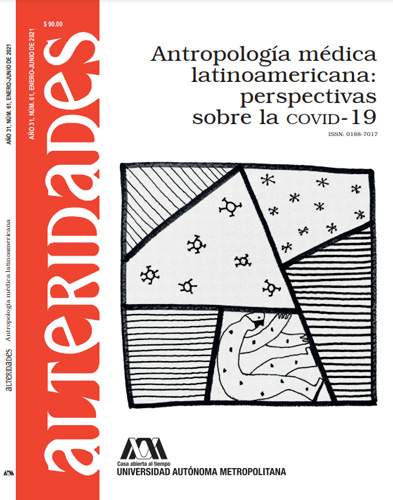
Pérez, Ana Victoria Morán. 2021. “Los consultorios adyacentes a farmacia en tiempos de covid-19: crisis y omisiones del sector salud (Pharmacy-adjacent doctor’s office during covid-19: Crisis and ommisions by the healthcare sector)”. Alteridades 31(61): 9-20.
A pandemia de COVID-19 evidenciou a presença de Consultórios Adjacentes às Farmácias (CAF) como componente primordial do sistema de saúde mexicano. O objetivo deste artigo é analisar o papel dos CAFs durante a crise sanitária a partir da compreensão das representações sociais na perspectiva da equipe médica. Com base em entrevistas semiestruturadas com médicos que trabalham nesses consultórios, localizados na Cidade do México, bem como em uma revisão de fontes secundárias, são evidenciados os elementos para manejar a COVID-19 e os fatores que influenciam na percepção de risco da equipe pesquisada. Conclui-se que apesar das omissões do sistema de saúde em incluir tais consultórios como serviços oficiais, estes são peça fundamental na atenção à doença causada pelo coronavírus. Além disso, a equipe médica teve a necessidade de readequar seus conhecimentos e práticas frente às novas condições.
The covid-19 pandemic revealed the presence of the offices adjacent to private pharmacies (oapp) as a core component of the Mexican health system. The aim of this text is to examine the role of oapp during the health crisis, based on the social portrayal of the oapp’s doctors. Based on semi-structured interviews with physicians from pharmacies located in Mexico City, as well as a review of secondary sources, the article presents the responses to covid-19 and the factors that influence the risk perception of this personnel. It is concluded that despite the omissions of the health sector to include such clinics in the official strategy, these are a fundamental piece in the attention to coronavirus, in which the oapp’s physicians have had the need to adjust their medical knowledge and practice to the new conditions.

Hartigan, John Jr.. 2021. “Knowing Animals: Multispecies Ethnography and the Scope”. American Anthropologist 123(4): 846-860.
Multispecies ethnographic projects are venturing “beyond the human” (Kohn 2013), but how far can they go and remain anthropological? The answer depends on whether such projects align with the surge of ethological research on animal cultures. Based on my fieldwork on wild horses in Galicia, Spain, I make a case for an ethologically informed ethnography that extends cultural analysis to other social species. In this project, I used ethological techniques of direct observation but analyzed the results using Erving Goffman’s concepts of face, footing, and civil inattention. My analysis inverts Clifford Geertz’s classic study of the Balinese cockfight by making horse sociality the center of analysis, rather than regarding these animals as representations of human status concerns. I argue that this approach can be usefully applied across the range of taxa that evince culture, particularly those caught up in conservation efforts. In developing this claim, I draw on ethnoprimatologists’ efforts to synthesize multispecies ethnography with ethological methods and perspectives.
Los proyectos etnográficos de multispecies se están aventurando “más allá de lo humano” (Kohn 2013), sin embargo, ¿qué tan lejos pueden llegar y permanecer antropológicos? La respuesta depende de sí tales proyectos se alinean con el aumento de investigación etológica en culturas animales. Basado en mi trabajo de campo sobre caballos salvajes en Galicia, España, argumento a favor de una etnografía informada etológicamente que extiende el análisis cultural a otras especies sociales. En este proyecto, usé técnicas etológicas de observación directa, pero analicé los resultados utilizando los conceptos de Erving Goffman acerca de la autoimagen, el alineamiento de la comunicación y la inatención civil. Mi análisis invierte el estudio clásico de Clifford Geertz de la pelea de gallos balineses al hacer la sociabilidad de los caballos el centro del análisis, en vez de mirar estos animales como representaciones de preocupaciones del estatus humano. Argumento que esta aproximación puede ser aplicada útilmente a través del rango de taxones que evidencian cultura, particularmente aquellos envueltos en esfuerzos de conservación.

Chitra, V.. 2021. “Waste’s translations: Estuaries, marine life, and the chemistry of Mumbai’s dumping grounds”. American Ethnologist 48(4): 337-356.
Mumbai’s dumping grounds, located on the city’s estuarine edge, are sites where garbage and marsh are turned into salable land. This process of translating waste into land depends on keeping matter, beings, and landscapes separate and on limiting their interactions. Yet waste and the marsh interact and transform in ways that escape managerial discourse, revealing a haze of category and control errors that complicate knowledge, agency, and responsibility. While developers translate waste to land in relation to developmental goals, fishing communities, scientists, and activists translate it differently: scientists translate it in relation to chemical properties, interactions, and timelines; marine-life activists draw attention to its coastal ecologies; and fisher communities look for productive possibilities on a polluted shore. These translations attend to the inseparability of waste substances from the coast and its futures. They articulate a politics that acknowledges waste’s sociopolitics, material agency, temporalities, and multispecies ethics.
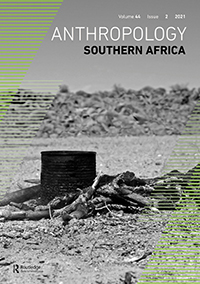
Basure, Hardlife Stephen, Lloyd Nhodo, Charles Dube and Roselyn Kanyemba. 2021. “Death and the sociocultural dimensions of forced relocations: experiences from the Tugwi-Mukosi displacement in Masvingo Province, Zimbabwe”. Anthropology Southern Africa 44(2): 80-93.
This article is an ethnographic inquiry into the cultural dimensions of forced relocations. It is based on the experiences of four resident anthropologists on the forced displacements at Tugwi-Mukosi in Masvingo province, Zimbabwe. Using the concept of death, we question the idea of belonging and what is regarded as an “honourable” way of exiting this world. These are interwoven in the cultural fabric of most Zimbabwean communities and any phenomenon that severs this tie to home is a cause of discomfort and pain amongst local people. Forced displacements have altered issues of honour associated with death rituals. We use death rituals as a window to understand the sociocultural effects of displacement. Novel ways of dealing with death are witnessed as people struggle with lack of a permanent “home.” The sacredness of cultural dimensions of death has been reconfigured in ways that have left the displaced struggling to find closure in dealing with the dead. Death rituals give us an opportunity to understand the multifaceted effects of displacement. Through death we experience the pain of displacement, understand the chords that bind the displaced communities together and witness the enduring social bonds that structure life beyond the disruptions of displacement.
Este artigo é uma investigação etnográfica sobre as dimensões culturais das realocações forçadas. Este se baseia nas experiências de quatro antropólogos membros na comunidade que sofreu as remoções forçadas em Tugwi Mukosi na província de Masvingo, no Zimbabwe. Usando o conceito de morte, questionamos a ideia de pertencer e o que é considerado uma forma “honrosa” de sair deste mundo. Estas duas noções estão entrelaçadas no tecido cultural da maioria das comunidades do Zimbabwe e qualquer fenómeno que rompa esse vínculo com o lar é uma causa de desconforto e dor entre a população local. As realocações forçadas alteraram as questões de honra associadas aos rituais de morte. Usamos os rituais de morte como uma janela para compreender os efeitos socioculturais do deslocamento. Novas formas de lidar com a morte são testemunhadas à medida que as pessoas lutam contra a falta de um “lar” permanente. A sacralidade das dimensões culturais da morte foi reconfigurada a tal ponto que deixou os deslocados com dificuldades para encontrar o sentido de conclusão ao lidar com os mortos. Os rituais de morte nos dão a oportunidade de compreender os efeitos multifacetados das realocações. Por meio da morte, experimentamos a dor do deslocamento, compreendemos os acordes que unem as comunidades deslocadas e testemunhamos os laços sociais duradouros que estruturam a vida além das rupturas das realocações.

Del Olmo Morales, Miguel Ángel. 2021. “Trabajadoras sexuales y relaciones de poder en el ámbito de la prostitución (Sex workers and power relations in the field of prostitution)”. Antropología Experimental 21(8): 107-120.
Se da por hecho, bajo una concepción victimista, que las relaciones sociales que establecen las trabajadoras sexuales siempre son asimétricas e impuestas por los demás actores que intervienen en la prostitución. Sin embargo, las relaciones de poder que se establecen en el ámbito de la prostitución funcionan como en cualquier otro ámbito social. Las trabajadoras sexuales diseñan y llevan a cabo todo tipo de estrategias y resistencias para obtener el mayor beneficio en las relaciones de poder que establecen con sus clientes. La seducción, la selección y la elección de los clientes, junto a la experiencia y el saber acumulado, empodera a las trabajadoras sexuales para la negociación y la consecución de sus objetivos, conformando una imagen que pone de manifiesto que las trabajadoras sexuales tienen mucho más poder del que se les atribuye.
It is presumed, according to a victimizing conception, that the social relations established by sex workers are always asymmetric and imposed by the other actors involved in prostitution. However, the power relations established in the field of prostitution function as in any other social sphere. Sex workers design and accomplish all kinds of strategies and resistances to obtain the greatest benefit in the power relations they establish with their clients. The seduction, the selection and the election of the clients, together with the experience and accumulated knowledge, empowers the sex workers for the negotiation and the achievement of their objectives, creating
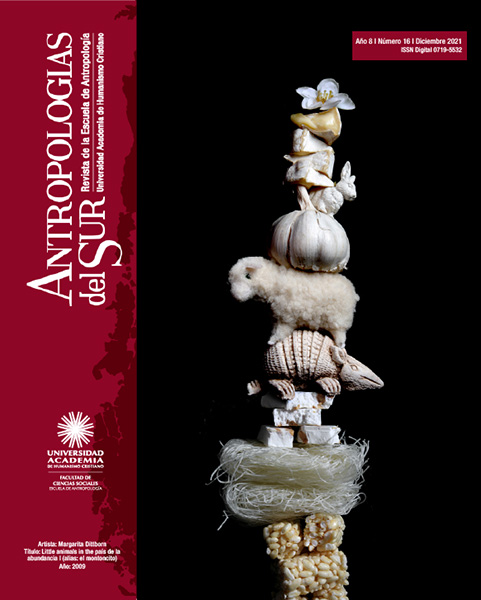
Leyva Solano, Xochitl. 2021. “Aportes desde los márgenes a la co-creación de prácticas otras de conocimientos (Contributions from the Margins to Co-creation of Other Knowledge Practices)”. Antropologías del Sur 8(16): 115-131.
Mi punto de partida son los despojos epistémicos que trajo consigo el disciplinamiento antropológico. Me enfoco en las prácticas otras de conocimientos y las contribuciones que hacen a las ciencias sociales las mujeres y otres racializadas rebeldes en los actuales tiempos de violencia y muerte. De la mano de comunicadoras comunitarias indígenas y garífunas abordo las formas otras de entender lo que en términos académicos llamamos “comunicación”. Reflexiono sobre algunos aportes epistémico-teórico-políticos zapatistas efectuados en medio de las guerras. Cierro sugiriendo que todas estas luchas epistémico-políticas pueden verse como un aporte colectivo desde los márgenes a eso que aún llamamos antropologías latinoamericanas.
My starting point is the epistemic dispossession that anthropological thought and discipline has brought with it. I will focus on other knowledge practices and the contributions that women, trans-gender and racialized others have made to the social sciences in our current times that are marked by widespread violence and death. Based on our work with indigenous and Garifuna community communicators, I address other ways of understanding what, in academic terms, we call “communication”. This leads me to reflect on some of the Zapatista epistemic-theoretical-political contributions made in the midst of warfare. I conclude suggesting that all these epistemic and political struggles can be understood as a collective contribution made from the margins to what we still call Latin American anthropologies.
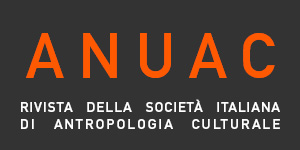
de Matos, Patricia Alves and Alessandro Deiana (eds). 2021. "David Graeber: antropologia, anarchia, attivismo / David Graeber: Anthropology, anarchy, activism". Anuac 10(1): 15-48.
International bilingual forum in memory of David Graeber. Contributions by Patrícia Alves de Matos (CRIA/ISCTE - Instituto Universitário de Lisboa), Stefano Boni (University of Modena and Reggio Emilia), Dimitris Dalakoglou (Vrije Universiteit Amsterdam), Alessandro Deiana (University of Cagliari), Nika Dubrovsky (David Graeber Institute).
Forum internazionale bilingue in memoria di David Graeber. Contributi di Patrícia Alves de Matos (CRIA/ISCTE - Instituto Universitário de Lisboa), Stefano Boni (Università di Modena e Reggio Emilia), Dimitris Dalakoglou (Vrije Universiteit Amsterdam), Alessandro Deiana (Università di Cagliari), Nika Dubrovsky (David Graeber Institute).
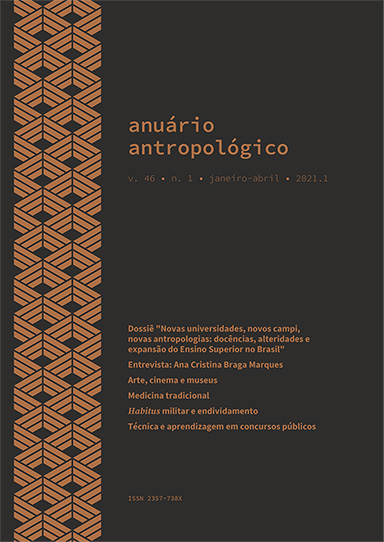
Martes, Ana Cristina Braga, Soraya Fleischer and Edna de Almeida. 2021. “ENTREVISTA”. Anuário Antropológico 46(1): 274-295.
Entrevista com Ana Cristina Braga Martes, socióloga e cientista política trabalhando em São Paulo. Em 2019, a autora lançou A origem da água ( Rio de Janeiro: Confraria do Vento, 2019), seu romance de estreia. De modo remoto, em maio de 2020, a entrevista foi realizada por Soraya Fleischer e Edna de Almeida. O objetivo principal foi dialogar sobre as proximidades e rentabilidades mútuas entre a Literatura e as Ciências Sociais, a Antropologia em particular, sobre os temas da saúde mental, instituições de saúde, gênero e trajetórias de vida.
Interview with Ana Cristina Braga Martes, sociologist and political scientist working in São Paulo. In 2019, the author published The Origin of Water (Rio de Janeiro: Confraria do Vento, 2019), her debut novel. Remotely, during May 2020, Soraya Fleischer and Edna de Almeida conducted the interview. The main goal was to discuss the proximity and mutual profitability between Literature and Social Sciences. Anthropology in particular, on the themes of mental health, health institutions, gender and life trajectories.
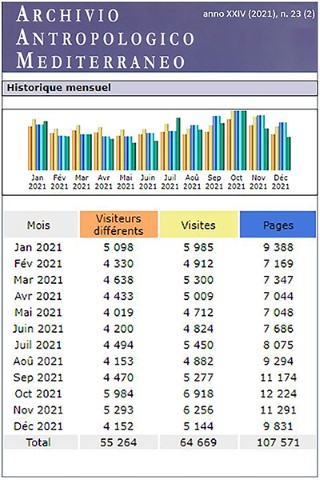
Volpi, Laura. 2021. “Walking in the footsteps of the forefathers. The concept of “ancestry” between political use of molecular biology and indigenous territory, understood as a relationship between the living and the dead (Camminando sulle orme degli antenati. Il concetto di “ascendenza” tra un uso politico della biologia molecolare e il territorio indigeno, inteso come spazio di relazione tra vivi e defunti)”. Archivio antropologico mediterraneo 23(2).
Kichwa indigenous people of the Peruvian Amazon Forest have been facing, for several years, a territorial conflict due to the establishment of a natural park on their homelands. In order to question the legitimacy of native claims, the Regional Government puts forward the hypothesis of the Andean kichwa migration. On the other hand, several NGOs hope to help this native people, using some biomolecular investigations that “scientifically certify” its Amazonian origins and its ancestral relationship with the surrounding territories. However, the natives seem lukewarm to the uncritical acquisition of a strategic discourse based on the rhetoric of “temporal primacy”. Thus, despite having assimilated an ancestral-genetic discourse, they reshape it in light of a more relational conception of territory. The latter, far from being considered an inheritance transmitted from one generation to the other, is seen as a peculiar space of conservation and generation of memory, in which the living constantly interweave present and active relationships with the dead. Walking in the footsteps of the forefathers.
I nativi kichwa dell’Alta Amazzonia peruviana stanno affrontando, da diversi anni, un conflitto territoriale dovuto alla creazione di un Parco Naturale Protetto sulle loro terre d’origine. Per mettere in dubbio la legittimità delle loro rivendicazioni politiche, gli enti regionali sostengono l’ipotesi della loro antica migrazione andina. Al contrario, diverse ONG locali promuovono l’uso politico di alcune indagini biomolecolari capaci di “certificare scientificamente” le origini amazzoniche di questo popolo e la sua conseguente relazione ancestrale con i territori circostanti. Molti individui nativi, però, si mostrano scettici di fronte all’acquisizione di una narrazione strategica basata sulla retorica del “primato temporale”. Così, pur avendo assimilato il discorso ancestrale-genetico, lo rimodellano alla luce di una concezione nativa e relazionale del territorio. Quest’ultimo, lungi dall’essere considerato un’eredità trasmessa di generazione in generazione, viene visto come un peculiare spazio di conservazione e generazione della memoria, in cui i vivi intrecciano costantemente relazioni presenti e attive con i defunti.

Farrer, James and Chuanfei Wang. 2021. “Who owns a cuisine? The grassroots politics of Japanese food in Europe”. Asian Anthropology 20(1): 12-29.
Culinary borrowings are so common as to seem trivial, and yet they are consequential for many of the actors concerned. People’s livelihoods, professional status, and social identity may be tied to their stake in the defining boundaries of culinary cultures. When dominant groups or powerful actors such as multinational corporate chains adopt or reinvent the cuisine of weaker and marginal groups, it may be regarded as cultural appropriation. However, the definition of the situation becomes more complicated when multiple weak and marginal actors compete over ownership of a cuisine. This article discusses how Japanese and other Asian migrant actors participate in grassroots culinary politics surrounding definitions and uses of Japanese cuisine in the context of a Japanese food boom in Europe. It shows how the “borrowed power” of one migrant group may threaten the status and even livelihoods of the foundational stakeholders in a culinary field.

Malagodi, Mara. 2021. “Holy Cows and Constitutional Nationalism in Nepal”. Asian Ethnology 80(1): 93-119.
The way in which the Nepali state has framed over the centuries the legal framework protecting the cow—Hinduism’s sacred animal—illuminates the intimate relationship between state-framed nation-building and the management of sociocultural diversity in Nepal, the only other Hindu-majority state in the world alongside India. Nepal’s 2015 Constitution, while declaring the state secular, continues to grant Hinduism a privileged place and to define the cow as Nepal’s national animal. To understand the symbolic significance of these constitutional provisions in the construction of the Nepali nation and their material impact on Nepal’s marginalized groups, it is crucial to analyze their historical development and their relationship to other parts of the constitution and to ordinary laws criminalizing cow slaughter. This article argues that cow protection has come to signify a vision of state authority that privileges the symbols of the majority over the rights of the minority—a vision channeled through the coercive instrument of law.
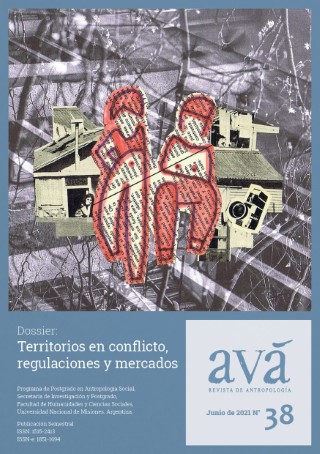
Bandeira, Gustavo Andrada and Alejo Levoratti. 2021. “REFLEXIONES METODOLÓGICAS SOBRE LAS INTERACCIONES SOCIALES DEL INVESTIGADOR EN EL ESTUDIO DEL DEPORTE Y LA EDUCACIÓN FÍSICA (Methodological reflections on the social interactions of the researcher in the study of sport and physical education)”. Avá Revista de Antropología 38: 339-358.
El presente artículo tiene por objetivo producir un análisis teóricometodológico sobre el lugar del investigador en el proceso de construcción de los datos en investigaciones sobre las prácticas deportivas y la educación física. Mediante un abordaje comparativo procuramos problematizar las reflexividades puestas en juego durante el trabajo de campo y su lugar en la producción de los datos, a partir de dos investigaciones que abordaron a los hinchas de fútbol y a profesores de educación física. En este trabajo pretendemos explicitar los límites y las posibilidades de circular por un campo bastante conocido para el investigador. Ello nos llevó a problematizar la identidad del investigador, la construcción del cuerpo y las repercusiones posibles de nuestros escritos. Estas reflexiones buscarán poner en evidencia la necesidad de problematizar y explicitar la relación sujeto-objeto en las producciones del campo de los estudios sociales sobre el deporte.
This article brings a theoretical-methodological analysis of the researcher’s positionality when constructing data in sports practices and physical education research. We examine the plural forms of reflexivity put into play during the fieldwork and how they affect data production. Using a comparative approach, we explore two investigations that addressed football fans and physical education teachers. However, in this work, we intend to make explicit the limits and possibilities of moving in a pretty well-known field to the researcher. This problem made us interrogate three elements: the identity of the researcher, the construction of the body, and the possible repercussions of our writings. These reflections seek to highlight the need to problematize and make explicit the subject-object relations within social studies of sports scholarship.
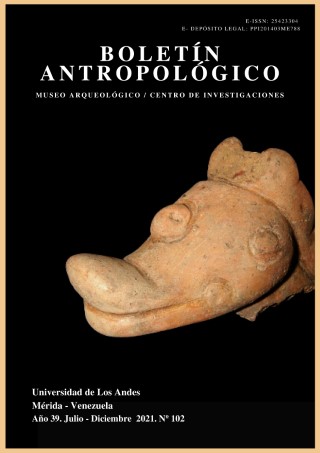
Florez, Carlos David Rodríguez. 2021. “Contribución de la antropología dental al conocimiento de los orígenes biológicos de algunos grupos indígenas contemporáneos en el Norte de Sudamérica (Contribution of dental anthropology to the knowledge of the biological origins of some contemporary indigenous groups in Northern South America)”. Boletín Antropológico 102(2): 400-424.
Se realiza una breve revisión y actualización del modelo teórico que explica el origen de los grupos humanos en Sudamérica desde el punto de vista dental. Se debate su aplicación en la región del Norte de Sudamérica y se aporta un análisis de grupos indígenas contemporáneos para verificar si la variación encontrada se explica por este modelo. Se debate que es necesario incluir algunos elementos metodológicos y técnicos, así como un mayor número de muestras sudamericanas para mejorar este modelo teórico y que sea complementario a la investigación y registro que posee la arqueología de la region
A brief review and update of the theoretical model that explains the origin of human groups in South America from the dental point of view are carried out. Its application in the northern region of South America is discussed and an analysis of contemporary indigenous groups is provided to verify if the variation found is explained by this model. It is debated that it is necessary to include some methodological and technical elements, as well as a greater number of South American samples to improve this theoretical model and that it be complementary to the research and record of the archeology of the region.

Conrad, JoAnn. 2021. "Neither Reform nor Rescue: “Woman's Work,” Ordinary Culture, and the Articulation of Modern Swedish Femininities". Ethnologia Europaea 51(1): 99-136.
This article examines the role of women in the construction of modern Swedish subjectivity through their participation in both quotidian activities and their networks of relations. Taking the work of Barbro Klein as a point of departure, I argue that Swedish women of the fin de siècle worked within overlapping and interconnected women’s networks through which they fashioned their own responses to the pressures of modernity within particular configurations of gender. Combining the social and political, formal and informal, labor and leisure, they created spaces for alternate cultural, commercial and social responses. These spaces from which femininity was lived as a positionality in discourse and social practice challenge the false dichotomies of past–future and tradition–modernity which have been central to the disciplinary narrative of folklore studies.
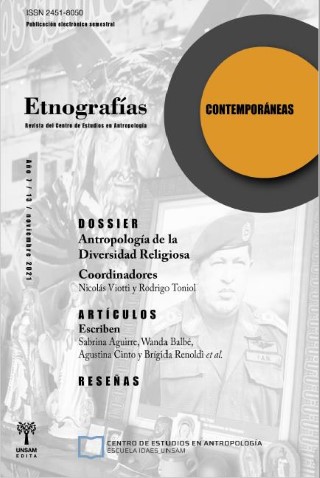
Hernández, Luis Alonso. 2021. “El ritual a San Hugo Chávez. Solidaridad, efervescencia y reafirmación revolucionaria (The ritual of San Hugo Chávez: solidarity, effervescence and revolutionary reaffirmation)”. Etnografías Contemporáneas 7(13): 248-268.
El artículo describe prácticas de sacralización en torno a la figura de Hugo Chávez, específicamente los hechos que se registran cada 5 de marzo, fecha en la que se conmemora la muerte del expresidente venezolano. Estas acciones se han visibilizado en una popular barriada caraqueña llamada 23 de enero, ubicada al oeste de la capital venezolana, sector en el que un grupo de vecinos construyó una capilla consagrada a San Hugo Chávez, convertida en epicentro del culto sagrado a este líder político. Partiendo de las posiciones teóricas de Catherine Bell sobre prácticas de ritualización y de Víctor Turner acerca del sentido de communitas, se analiza etnográficamente la ceremonia que se realizó en esta capilla en marzo de 2018, en la cual los participantes niegan la muerte y prefieren hablar de la “siembra del comandante eterno y supremo”, es decir, de las raíces profundas que, desde su perspectiva, siguen consolidando a la Revolución Bolivariana. Posteriormente, afirmo, cómo esta fiesta del cinco de marzo es al mismo tiempo, religiosa y política. Desde el punto de vista del culto, se reafirma la vivencia en donde Chávez es simultáneamente una figura suprahumana que opera en el mundo de los vivos y, a su vez, una figura humana que se rememora por sus actos políticos desarrollados como Jefe de Estado.
The article describes sacralization practices in relation to the image of Hugo Chavez, specifically the events that take place annually on March 5th, to commemorate the dea- th of the Venezuelan ex-president, specially in a low income neighborhood in Caracas called "23 de Enero" located west of the Venezuelan capital. In this area of the city the residents built a chapel consecrated to Saint Hugo Chavez, this place became the epi- center of the sacred cult to this political leader. Based on the theoretical approach of Catherine Bell about ritualization practices, and Victor Turner ́s notion of communitas, the ceremony that took place in this chapel in March 2018 is analyzed based on eth- nographic research. In this recent event its participants deny the death of this political leader, and they refer to "the sowing of the eternal and supreme commander", which means that according to the practitioners the deep roots continue to consolidate the Bolivarian Revolution. Later on I examine how this celebration on March 5th is, at the same time, political and religious. From the cult perspective, the belief that Chavez is a superhuman figure reaffirmed the experience that he operates in the world of the living as a human figure that is remembered for his political actions as a chief of state.

Goldstein, Donna and Kira Hall. 2021. “Darwin's hug: Ideologies of gesture in the science of human exceptionalism”. HAU: Journal of Ethnographic Theory 11(2): 693-712.
This article reviews accounts of “hugging” across evolutionary paradigms to expose how understandings of gesture are shaped by scientific theorizations of the ways humans and animals differ. The divergent roles assigned to gesture in human communication by Vygotskian and Chomskyan researchers can be traced to research on human exceptionalism during key historical periods in the Soviet Union and United States. When Vygotsky introduced his sociocultural theory of cognitive development during the early Soviet period, human exceptionalism was tested through reproductive crossbreeding. When Chomsky hypothesized a language acquisition device for the human brain during the Civil Rights era, human exceptionalism was tested through interspecies communication. These scientific histories inspired critically different approaches to gestural meaning. Taking a fresh look at the great ape language debates of the 1970s, the article attributes the dismissal of ethnography in late twentieth-century human language study to a developing experimental protocol that required gesture’s eviction.
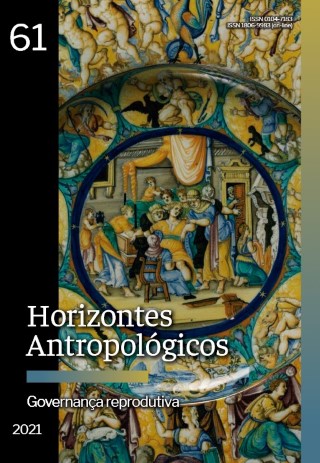
Fonseca, Claudia, Diane Marre and Fernanda Rifiotis. 2021. “Governança reprodutiva: um assunto de suma relevância política (Reproductive Governance: a subject of extreme political relevance)”. Horizontes Antropológicos 27(61): 7-46.
Nesta análise centrada em estudos etnográficos da governaça reprodutiva, consideramos as diferentes perspectivas analíticas que se delineiam nos últimos anos sobre a reprodução estratificada, os regimes morais de maternidade, cuidado e trabalho nas rotinas reprodutivas e a agência/ação transformativa nas práticas familiares. Apesar da variedade de temas – desde a saúde da mulher, concepção e gravidez até diferentes formas de prática e moralidade materna – encontramos um fio comum, característico dos estudos feministas desde os anos 1990, enfatizando não apenas como a reprodução humana está enredada em interesses coletivos e forças políticas, mas como todas as políticas governamentais são políticas reprodutivas (Briggs 2017). Nessa literatura, a reprodução humana, longe de ser um fenômeno biológico bem delimitado, constitui um tema ao mesmo tempo material e político, entrelaçado com questões de gênero e sexualidade, estado, raça e mercado que, por meio de corpos e afetos, interligam acontecimentos microscópicos com transnacionais processos. Ao longo de nossa discussão, graças a um diálogo forjado entre as três co-autoras, desenvolvemos uma comparação tácita entre ênfases acadêmicas em diferentes regiões (Norte - Sul; Europa/EUA e América Latina) e diferentes países (com maior ênfase na América do Sul ´s Cone Sul e Espanha) contra o pano de fundo sempre presente dos fluxos globais.
In this analysis focused on ethnographic studies of reproductive governance, we consider different analytical perspectives taking shape in recent years concerning stratified reproduction, moral regimes of motherhood, care and work in reproductive routines and transformative agency/action in family practices. Despite the variety of themes -- from women's health, conception, and pregnancy to different forms of maternal practice and morality – we find a common thread, characteristic of feminist studies since the 1990s, emphasizing not only how human reproduction is enmeshed in collective interests and political forces, but how all government policies are reproductive policies (Briggs 2017). In this literature, human reproduction, far from being a well-delimited biological phenomenon, constitutes a subject both material and political, intertwined with issues of gender and sexuality, state, race and market that, via bodies and affects, interconnect microscopic happenings with transnational processes. Throughout our discussion, thanks to the dialogue forged between the three co-authors, we develop a tacit comparison between scholarly emphases in different regions (North - South; Europe /USA and Latin America) and different countries (with greater emphasis on S. America´s Southern Cone and Spain) against the ever-present background of global flows.
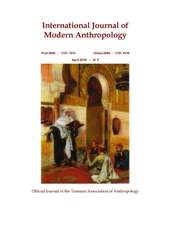
Holl, Augustin F.C.. 2021. “Megaliths in Tropical Africa: Social Dynamics and Mortuary Practices in Ancient Senegambia (ca. 1350 BCE – 1500 CE)”. International Journal of Modern Anthropology 2(15): 363-412.
When analyzed systematically, Tropical Africa megalithism appears to have emerged in contexts of friction between different lifeways, agriculturalists versus foragers, pastoralists versus hunter-gatherers-fishermen, or agriculturalists versus fishing folks. The monuments built were clearly part of actual territorial strategies. Research conducted by the Sine Ngayene Archaeological Project (2002-2012) frontally addressed the “Why” of the emergence of megalithism in that part of the world, and probes the reasons for the performance of the elaborate burial practices preserved in the archaeological record. This paper emphasizes the diversity and complexity of burial protocols invented by Senegambian “megalith-builders” communities from 1450 BCE to 1500 CE. Senegambian megalithism is shown to have proceeded from territorial marking imperatives, shaping a multi-layered cultural landscape through the implemented mortuary programs anchored on the construction of Ancestorhood.
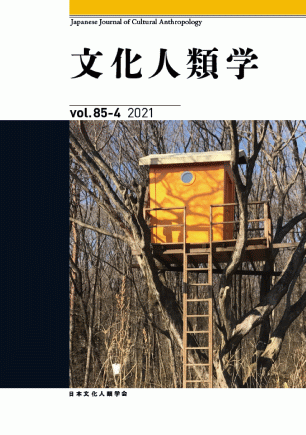
張詩雋 (Shijun Zhang). 2021. “神仏の肖像−チベット・タンカの制作と崇拝について (The Portrait of Buddha: An Anthropological Approach toward the Tibetan Religious Painting—Thangka)”. 文化人類学 (Japanese Journal of Cultural Anthropology) 85(4): 640-658.
肖像とは、何かにあやかり造られる像のことであり、人間の感情や願望に常に深く関連している。本稿の考察対象であるチベット・タンカは、チベット仏教やボン教の神仏を表現するのみならず、制作者や崇拝者の感情や願望を喚起させる神仏の肖像でもある。本稿では、タンカの制作・崇拝に関する事例の人類学的記述を通して、人間と肖像、主体と客体の関係がいかに撹乱されるかを考察する。タンカ制作には以下の3つの特徴がある。①数値化される規則がタンカの宗教性を決めること。②数値化されない規則――本稿ではそれを「不可量の部分」と呼ぶ――はタンカの審美性に大きく関与すること。③身体物質を使用することが、タンカの宗教性と審美性の両方に関係すること。タンカに関する先行研究では、①は重要視されてきたが、②と③への考察は十分になされていない。本稿では②タンカ制作における不可量部分、および③絵師の身体物質の使用に注目する。そしてタンカの魅力、あるいはタンカのエージェンシーの発生は、単に宗教的意味や視覚的美しさだけでなく、制作者がタンカと一体化する願望を実現させようとする点にあるとみなして、タンカの身体美学性を主張する。さらに本稿の後半では、タンカの依頼・使用の事例を紹介し、人間とタンカ間の「変身」が相互的であることを示す。人が像を造ることは、像に促され、制作者になることであり、制作者と肖像――人とモノ――は対面に置かれる鏡面のように、延々と反射し合う関係にある。
A portrait is an image created in imitation of something, and it is always deeply related to human emotions and aspirations. Tibetan thangkas, the subject of this paper, are not only representations of the Buddha and deities of theTibetan Buddhist and Bön religion but also can be viewed as a kind of portrait that evokes the emotions and aspirations of their creators and worshippers. This paper examines how the relationship between human and portrait, subject and object, is disturbed through anthropological descriptions of cases of thangka creation and worship. Thangka-making is characterised by the following three features: (i) the quantitative rules determine the religious authenticity of the thangka, (ii) the non-quantitative rules (referred to in this paper as the ‘imponderabilia part’, play a significant role in the aesthetic quality of the thangka, and (iii) the use of bodily substances is related to both the religious and aesthetic quality of thangkas. In previous studies on thangkas, (i) has been considered important, but consideration of (ii) and (iii) has been insufficient. This paper focuses on (ii) the ‘imponderabilia part’ of thangka-making and (iii) the painters’ use of bodily substances. It then argues for the ‘corpothetics’ of the thangka, considering that the appeal of the thangka, or the emergence of the thangka’s agency, lies not merely in its religious meaning or visual beauty but in its creator’s attempt to fulfil his or her desire to unify with the thangka. Furthermore, the second half of the paper presents examples of the commissioning and use of thangkas to show that the ‘transformation’ between humans and thangkas is two-way. A person who creates a portrait is constantly enchanted by the portrait and then become a creator. The creator and the portrait, the person and object, are in an endlessly reflective relationship, like mirrored surfaces placed face to face.
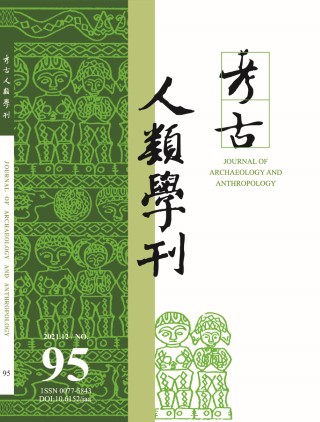
呂欣怡(Hsin-yi Lu). 2021. “工業隙縫裡的盆栽景觀:人與樹在失調環境中的符應與共生(Bonsai-scape in an Industrial Crevice Space On the Possibilities of Co-dwelling and Correspondence of Humans and Trees in a Disturbed Environment)”. 考古人類學刊 (Journal of Archaeology and Anthropology) 95: 1-44.
斑駁鏽蝕的工業設施與綠意盎然的盆栽矮樹之並置,構築了前高雄煉油廠周邊饒富興味的盆栽景觀。本文從Tim Ingold提出的「寓居視角」來檢視後勁盆栽園裡的生命境況,分析人與樹如何可能在受到工業嚴重干擾的失調環境中寓居與共生。「符應」(correspondence)是本文的關鍵概念,用來描述人與樹的親近性,以及盆栽與工業環境的共存。本研究有三項主要發現,首先,盆栽農在長期養樹的過程中,藉由修剪塑型等等身體動作,以及樹(包括樹皮、樹枝、樹葉等)的觸感給予的回應,與樹共同造就了盆栽。第二,在盆栽園中,由於樹需要密集澆灌與修剪,以及其固著一地的特性,召喚人每日定時至園中勞動,從而打造了一個符應樹之日常需求的共同寓居場所,園中盆栽之可視狀態,替代了言語而成為符應照顧之人生活狀態的具體線索。第三,我從區域的經濟與地景變遷來理解盆栽園出現於此地的緣由,並由此詮釋盆栽形貌與工業都市的符應。人、樹、社群的生命共振,構築了工業設施隙縫中的生機世界。
The juxtaposition of rustic industrial facilities and lush potted trees in Houjin community creates an intriguing bonsai-scape in the space adjacent to the former Kaohsiung oil refinery. This paper examines the life world in Houjin’s bonsai garden from the “dwelling perspective,” conceptualized by Tim Ingold, and analyzes how people and trees can live and grow together in an environment severely disturbed by industrial activities. "Correspondence" is the key concept adopted in this paper to explicate the affinities between humans and trees, as well as the coexistence of bonsais and the industrial environment in which they reside. I draw three conclusions from the field study: First, bonsai can be viewed as a co-creation by the bonsai grower and the tree because its long cultivation process involves a combination of human actions such as pruning and shaping, as well as the tree’s tactile responses through bark, branches and leaves. Second, the intensive watering and pruning required to meet the trees’ biological needs, as well as the trees’ fixation with the ground, have structured the regular work pattern in the garden and created a dwelling place that corresponds to the daily needs of the tree. The visible state of the garden plants has replaced words as concrete clues that correspond to the life conditions of the bonsai growers. Third, I investigate the reason why bonsai agriculture was able to emerge in this area and how the appearance of the bonsai garden corresponds to the formation of the industrial city. The people, the trees and the community have co-constructed a vibrant world with their lives resonating in this crevice amidst industrial facilities.
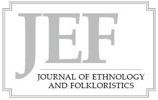
Oprelianska, Alina. 2021. “The Sealed Grave and Burial Rituals in the Context of Revenants in Ukrainian Belief”. Journal of Ethnology and Folkloristics15(1): 27-49.
The article sets the goal of describing the Ukrainian ritual of the sealed grave and its relation to revenants, or the unquiet dead, based both on the author’s fieldwork and ethnographic collections of the turn of the 20th century. The meaning of the ritual and its variants are delineated through folk beliefs and institutionalised Orthodoxy and are defined as one of the main reasons for becoming revenants. Depending on a proper or failed funeral, the dead have different possibilities and time boundaries to visit the living. Together with biological reasons, the ritual of sealing a grave allows a seven-year period of return prior to the grave being finally sealed.

Pradhan, Prerna. 2021. “Sparxan: ‘Seeing’ Menstruating Goddess Kamakhya through the ‘ritual touch’”. Journal of Indian Anthropological Society 56(3): 273-289.
This paper discusses how the conceptualization of menstruating goddess Kamakhya revolves around sparxan, the ritual act of touching the goddess. Here, the conventional mode of worship darxan (seeing/viewing the goddess) is effectively replaced by sparxan in order to ‘see’ and communicate with the goddess. However, to understand the complexity of worshipping Kamakhya, the paper explores two contrasting situations where Kamakhya is worshipped by performing and unperforming sparxan-nitya puja (the daily worship) and Ambubachi festival believed to be her menstrual period when she becomes inaccessible in sight and touch. In doing so, the paper argues that the act of sparxan subverts the traditional mode of worship prioritizing the elemental idea of auspicious touch over auspicious sight. But at the same time it also brings into question the ambivalence of howthe same goddess becomes touchable or untouchable and both the modes are accepted ways of ‘seeing’ the goddess albeit in two different events.
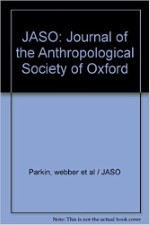
Padel, Felix. 2021. “TOWARDS AN ANTHROPOLOGY OF SPIES AND INTELLIGENCE AGENCIES”. Journal of the Anthropological Society of Oxford Online 13(2): 155-194.
This article studies how intelligence agencies work, on the premise that they form a key part of modern power structures, but despite being popular as a topic of fiction and investigation, are rarely subjected to careful anthropological or sociological analysis. This applies especially to the British ones, several facets of whose history from the second world war are traced here, emphasizing the highly effective disinformation they gave out against the Nazis, but also how several top Nazi spies were shielded from prosecution and rapidly deployed against the Russians. The article traces intelligence agencies' role in some of the most egregious regime changes, such as Iran and Indonesia, to focus particularly on the Kurdish experience, and their role in Syria; emphasizing their role in political interference against outspoken leftwing leaders, and also in particular the close control that intelligence agencies apparently exercise over mainstream media, encapsulated in Herman and Chomsky's phrase 'manufacturing consent'.

Jee, Eunsook. 2021. "Unmarried Daughters as Family Caregivers: Evolving Family Relationships, Gender Order, and Singlehood in Japan". Korean Anthropology Review: A Journal of Korean Anthropology in Translation 5: 85–116.
This study is based on an ethnography of daughters taking care of their parents in Tokyo, Japan. I focus on the allocation of caregiving responsibilities for elderly parents among their children, especially in terms of its effects on unmarried daughters and its impact on the "singlehood" of unmarried women. As in South Korea, research on singlehood in Japan has proceeded from the concerns with childbirth and reproduction, largely focusing on revealing singlehood's causes. However, in order to improve our understanding of the phenomena of increased life expectancy and non-marriage as well as the overall demographic trend toward an aging society, it is necessary to adjust the perspective of singlehood research. Therefore, in this study I attempt to portray the lives of unmarried individuals by describing the family relationships of unmarried, middle-aged women, especially unmarried daughters caring for their parents. Through this approach, I will expand the scope of singlehood research to include those engaged in family life that is actually happening rather than focusing on marriages that never took place. This approach can provide useful implications for understanding the changes in family relationships and gender order that are occurring in an aging society with a high prevalence of singlehood. Primary research data was collected through an on-site survey in Tokyo, which was conducted for 18 months at monthly meetings for daughters taking care of their parents. My focus here was on the strained relationships between caregiving daughters and care-receiving mothers and on the conflicts surrounding the work-caregiving balance. Furthermore, in this study I highlight the agency of unmarried women as they traverse the gender order. I trace the ways in which unmarried female caregivers facing diverse hardships are gaining a public voice while restructuring their "singlehood." And I explore how such efforts create gaps and possibilities within the family-based social system and the male-centered gender order.
이 연구는 일본 도쿄지역에서 실시한 부모를 돌보는 딸들에 대한 민족지 조사에 바탕하고 있다. 특히 비혼딸들을 중심으로 자녀세대 내에서 노인돌봄이 분배되는 방식과 그것이 비혼 여성의 '비혼됨(singlehood)'에 미치는 영향을 살피는 것에 초점을 두고 있다. 한국과 마찬가 지로 일본에서도 비혼에 대한 연구관심은 출산과 인구 재생산의 관점에서 비혼화의 원인을 밝히는 것에 편중되어 왔다. 그러나 급속한 고령화와 더불어 생애미혼자가 급증하고 있는 현실을 파악하기 위해서는 비혼문제에 접근하는 시각이 조정될 필요가 있다. 이 연구는 중 년 비혼여성의 가족관계 특히 비혼딸의 부모돌봄을 통해 비혼자의 생애에 접근하고자 한다. 즉 그들이 '하지 않은' 결혼이 아니라 실제로 '하고 있는' 가족생활로 비혼연구를 확장하려는 것이다. 이러한 접근은 고령화·비혼화 속에서 재편되고 있는 가족관계와 젠더질서의 변동 을 파악하는 데 유익한 시사점을 줄 것으로 기대한다. 연구의 주요자료는 도쿄에서 매월 개최되는 부모를 돌보는 딸들의 모임에 대한 1년 6개 월의 현장조사를 통해 수집했다. 연구내용은 다음과 같은 점에 초점을 두고 있다. 첫째는 무엇이 비혼딸을 부모돌봄의 최적합자로 만드는가를 파악하는 것이다. 특히 젠더규범과 결혼 여부에 따른 자녀 간 돌봄분배의 불균형에 주목한다. 둘째는 딸에게 좋은 돌봄자가 되라는 압력이 어떤 방식으로 나타나는지를 살피는 것이다. 돌봄제공자인 딸과 돌봄수혜자인 어머 니와의 긴장관계, 그리고 비혼딸이 돌봄제공자가 되었을 때 발생하는 일과 돌봄의 양립을 둘러싼 갈등에 초점을 맞춘다. 나아가 이 연구는 비혼여성들이 발휘하는 젠더질서를 횡단하 는 행위자성(agency)에 주목한다. 다중적 곤란에 직면한 비혼여성 돌봄자들이 어떤 방향으로 자신들의 '비혼됨'을 재구성하면서 사회적 목소리를 획득하는가를 추적하면서 그것이 가족 단위의 사회시스템과 남성중심의 젠더질서에 어떤 틈새와 가능성을 만들고 있는지를 탐색 한다.
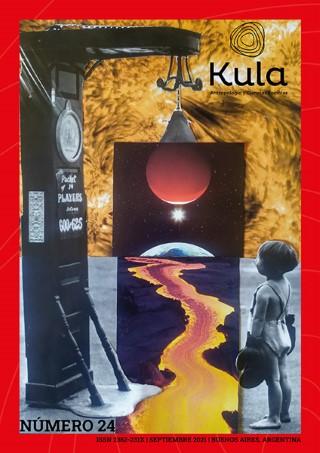
Levin, Axel. 2021. “CERTIFICACIÓN DE LA DISCAPACIDAD INFANTIL: DESMITIFICANDO UN MODELO MÉDICO QUE SE PRETENDE PASADO, Y UN MODELO SOCIAL QUE SE DICE VIGENTE (CERTIFICATION OF CHILD DISABILITY: DEMYSTIFYING A MEDICAL MODEL THAT IS CLAIMS TO BE OUTDATED, AND A SOCIAL MODEL THAT CLAIMS TO BE CURRENT)”. Kula. Antropología y Ciencias Sociales 24: 59-72
Este trabajo tiene como objetivo analizar las tensiones que atraviesan las prácticas y criterios de las profesionales de las Juntas que determinan la discapacidad infanto-juvenil, en particular la de los niño/ as que presentan patologías en salud mental. Se desarrollan distintos elementos que hacen a la mitificación de que el Estado argentino adoptó un modelo social de la discapacidad, y cómo las profesionales lo cuestionan. La investigación, cuyo enfoque fue etnográfico, se desarrolló en el Centro Integral de Evaluación y Orientación de la Discapacidad de la Ciudad Autónoma de Buenos Aires. En este marco, se problematiza el concepto de Estado para reflexionar sobre la gestión cotidiana de este organismo estatal, considerando la heterogeneidad de los actores sociales involucrados en la certificación. Se postula que la reificación del Estado contribuye a objetivar ciertos criterios y prácticas rutinizadas, y que las críticas de las profesionales forman parte de una disputa por su desmitificación.
This paper analyses the debates and tensions regarding the criteria and practices implemented by the evaluation boards in the city of Buenos Aires to certify disability in children and youth, particularly children with mental disorders. The common myth that the Argentinian State adopted a social model of disability is discussed, focusing on how the professionals question the validity of this idea. The research was based on an ethnographic approach, and field work was carried out in the Integral Centre for Evaluation and Orientation for Disabled People. Within this context, the study of this public institution leads us to a discussion about the concept of State itself, given the heterogeneous institutional actors involved in the certification. It is argued that the reification of the State contributes to objectify certain routinised practices and criteria, and that the professionals’ critiques are part of a dispute for its demystification.
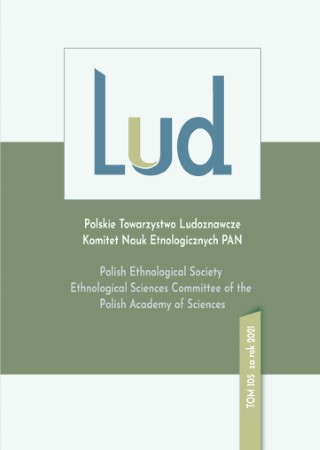
Kościańska, Agnieszka, Agnieszka Kosiorowska and Natalia Pomian. 2021. ““A WOMAN SHOULD FOLLOW HER OWN CONSCIENCE": UNDERSTANDING CATHOLIC INVOLVEMENT IN DEMONSTRATIONS AGAINST THE ABORTION BAN IN POLAND” („Kobieta powinna decydować w swoim sumieniu” –o katolickimi zaangażowaniu w protesty przeciwko zakazowi aborcji w Polsce)”. Lud. Journal of Polish Ethnological Association 105: 12-43.
In October 2020, a ruling by Poland’s Constitutional Tribunal effectively ending legal abortion incited mass protests across the country. Despite the demonstrations being directed at both the government and the Catholic Church, many devout Catholics joined the protests against the Church’s opposition to family planning being enacted through state-imposed prohibition. Drawing on ongoing archival and ethnographic research, in this paper we address a number of issues relating to Catholicism and abortion: how it is possible that so many Catholics decided to take part in pro-choice marches openly opposing official Catholic teaching on birth control? What were their motivations?
W październiku 2020 roku wyrok Trybunału Konstytucyjnego, znacząco ograniczający możliwość wykonywania legalnej aborcji w Polsce, wywołał masowe protesty w całym kraju. Do demonstracji przyłączyło się wielu pobożnych katolików, mimo że były one skierowane nie tylko przeciwko rządowi, ale i Kościołowi katolickiemu, popierającemu zmiany w prawie. Odpowiadają one bowiem jego oficjalnemu stanowisku wobec planowania rodziny.Bazując na badaniach archiwalnych i etnograficznych, w poniższej pracy przyglądamy się szeregowi kwestii związanych z katolicyzmem i aborcją: jak to możliwe, że tak wiele katoliczek zdecydowało się wziąć udział w protestach otwarcie sprzeciwiających się katolickiej nauce na temat kontroli urodzeń? Jakie były ich motywacje?
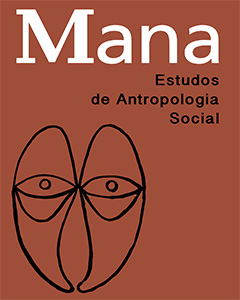
Marisol Marini. 2021. “A ATUAÇÃO DA IMAGINAÇÃO NO DESENVOLVIMENTO DE CORAÇÕES ARTIFICIAIS: POR UMA COMPREENSÃO DA CORPORIFICAÇÃO E PARTILHA DA IMAGINAÇÃO (The role of the imagination in the development of Artificial Hearts: towards an understanding of embodied and shared imagination)”. Mana. Estudos de Antropologia Social 27(2): 1-32.
O propósito do presente artigo é explorar o papel da imaginação na produção de dispositivos de assistência circulatória no âmbito da biomedicina moderna, tecnologias também conhecidas como Corações Artificiais. Os dados etnográficos sugerem a caracterização de uma imaginação marcada pelo engajamento material e corporal. O diálogo com teóricas feministas que propõem novos materialismos e com a antropologia da ciência e da tecnologia permite qualificar a matéria e reivindicar uma atenção às práticas. São abordagens que trazem para o primeiro plano a participação de distintas entidades e seres, permitindo observar o modo como as coisas podem se impor e contribuir para o molde de suas próprias formas, o que implica que, além de corporificado, o processo imaginativo encontra-se distribuído. Trata-se de (re) colocar a imaginação, que é comumente recusada ou pouco reconhecida na produção científica moderna purificada, destacando o engajamento material como essencial no processo de desenvolvimento tecnológico. A tarefa de descrever e reivindicar uma imaginação corporificada, partilhada e não reduzida à intencionalidade humana levará ao diálogo com abordagens e compreensões distintas sobre o processo criativo.
This article explores the role of imagination in the development of circulatory assistant devices, technologies also known as Artificial Hearts, by contemporary biomedicine. Ethnographic data suggests an imagination that is characterized by a material and corporeal engagement. Feminist theorists who propose new materialisms and the anthropology of science and technology provide a basis from which we can be attentive to practices in the enactment of new devices/bodies. These are theoretical approaches that foreground the participation of different entities and beings in the process of creating and developing medical technologies. A focus on practices allows us to observe how things can impinge on and contribute to the shape of their own forms, which implies that, in addition to being embodied, the imaginative process is also distributed. The article (re)situates the imagination, which is commonly rejected or sidelines in a purified modern scientific output, highlighting material engagement as an essential element in the process of technological development. The task of describing and claiming an embodied imagination, shared and not reduced to human intentionality, will establish a conversation with different approaches to and understandings of the creative process.
El propósito de este artículo es explorar el papel de la imaginación en la producción de dispositivos de asistencia circulatoria dentro del alcance de la biomedicina moderna, tecnología conocida como Corazones Artificiales. Los datos etnográficos sugieren la caracterización de una imaginación marcada por el compromiso material y corporal. El diálogo con teóricas feministas que proponen nuevos materialismos y con la antropología de la ciencia y la tecnología, permite calificar la materia y reivindicar una atención dirigida a las prácticas en el proceso de emergencia de nuevos dispositivos/cuerpos. Son enfoques teóricos que ponen en primer plano la participación de diferentes entidades y seres en el proceso de creación y desarrollo de tecnologías médicas. La mirada atenta a las prácticas nos permite observar el modo en el que las cosas pueden imponerse y contribuir en el molde de sus propias formas, lo que implica que además de materializarse, el proceso imaginativo se distribuye. Se trata de (re)poner la imaginación, comúnmente rechazada o poco reconocida en la producción científica moderna purificada, destacando la materialización como esencial en el proceso de desarrollo tecnológico. La tarea de describir y reivindicar una imaginación materializada, compartida y no reducida a la intencionalidad humana conducirá a un diálogo con diferentes enfoques y entendimientos sobre el proceso creativo.

Faust, Lene. 2021. “IM NAMEN DER TOTEN Neofaschismus in Italien: Krieg, Täterschaft und Trauma in transgenerationaler Perspektive”. Paideuma. Zeitschrift für kulturanthropologische Forschung 67: 169-192.
This article focuses on post-war fascism in Italy from a transgenerational perspective. It raises the question of the long-term effects of ‘historical’ scars and distortions caused by war, the perpetration of violence and trauma in family and society. The lack of reflection on the perpetuation of such scars, I argue, can contribute to subcultures establishing and developing social and political niches from which they interact with the majority society. A look at the consequences of experiences of war and the perpetration, repression and transmission of trauma and war experiences from a transgenerational perspective shows that analysing the anchoring of political culture in family spaces can provide painful insights into the ‘scarred’ culture of memory and different strategies of the political instrumentalisation of the past. Such a perspective on post-war fascism uncovers how deeply fractures or scars can be anchored in a society, how they are passed down generations and how they become permanent as a result. The transgenerational perspective is key to understanding the culture of remembrance and the neo-fascist scene in contemporary Italy, which has been consistently strong since 1945 as a consequence of the structural scarring of society over generations.
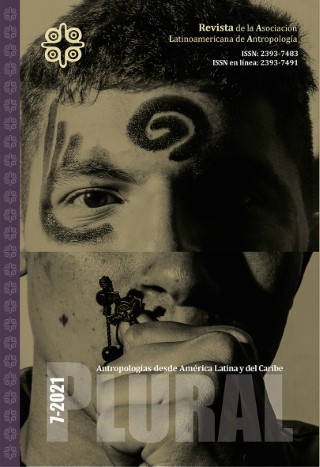
López, Pablo Sandoval. 2021. “Sobre las antropologías desde el sur y otras cuestiones urgentes (On anthropologies from the south and other urgent matters)”. Plural. Antropologías desde América Latina y del Caribe 4(7): 41-52.
Quizá lo más urgente sea construir plataformas de intercambio institucional desde las academias del sur que faciliten diálogos realmente horizontales, donde nuestras voces teóricas y propuestas etnográficas estén mejor representadas. Solo así se podrán conseguir reales intercambios académicos, propiciar la circulación de ideas y de investigadores, visibilizar publicaciones e incentivar escrituras antropológicas realmente experimentales. Descolonizar sí, pero sobre todo procurar conexiones institucionales y redes académicas entre nosotros, los del sur. Este desafío es planteado en un contexto en que nos enfrentamos a una nueva realidad universitaria: la estandarización académica.
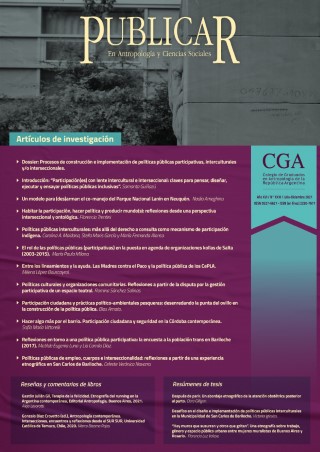
Trentini, Florencia. 2021. “Habitar la participación, hacer política y producir mundo(s): reflexiones desde una perspectiva interseccional y ontológica (Dwelling participation, doing politics and producing world(s): reflections from an intersectional and ontological perspective)”. PUBLICAR-En Antropología y Ciencias Sociales 31: 37-57.
El presente trabajo se propone analizar la(s) participación(es) de mujeres mapuche en el comanejo del Parque Nacional Nahuel Huapi desde una mirada interseccional que atienda a las múltiples violencias y luchas que se coconstituyen en sus cuerpos-territorios-vidas. A partir de esto sostengo que el comanejo se convierte en un espacio de afectividad y encuentro con otras/os (no siempre humanos), poniendo en cuestión las dicotomías de naturaleza/ cultura, político/espiritual, razón/emoción propias de la ontología moderna en la que se enmarca esta política. Frente a esto, la perspectiva de la ontología política permite atender a la(s) participación(es) de agentes no-humanos, abriendo la posibilidad de pluralizar esta política de conservación a partir del diálogo con el cuidado desde una perspectiva mapuche.
The present work aims to analyze the participation of Mapuche women in the comanagement of Nahuel Huapi National Park from an intersectional perspective that meets the multiple violence and struggles that are co-constituted in their bodies-territories-lives. From this I argue that comanagement becomes a space of affectivity and encounter with others (not always human), questioning the dichotomies of nature/culture, political/spiritual, reason/emotion typical of modern ontology in which this policy is framed. Faced with this, the perspective of political ontology allows addressing the participation(s) of non-human agents, opening the possibility of pluralizing this conservation policy from a dialogue with mapuche care perspective.
O presente trabalho tem como objetivo analisar a participação das mulheres Mapuche na cogestão do Parque Nacional Nahuel Huapi a partir de uma perspectiva intersetorial que aborda as múltiplas violências e lutas que se co-constituem em seus corpos-territórios-vidas. A partir disso, defendo que a co-gestão passa a ser um espaço de afetividade e encontro com outros (nem sempre humanos), questionando as dicotomias natureza / cultura, política / espiritual, razão / emoção próprias da ontologia moderna em que essa política se enquadra. Diante disso, a perspectiva da ontologia política permite abordar a(s) participação(ões) de agentes não humanos, abrindo a possibilidade de pluralizar essa política de conservação a partir de um diálogo com o cuidado na perspectiva mapuche.
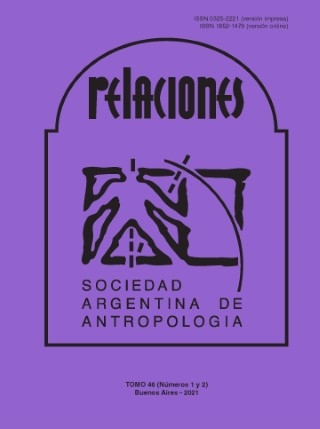
Campeny, Sara M. L. López and Andrés S. Romano. 2021. “SIGUIENDO EL HILO: ENSAMBLE CAMÉLIDOS-HUMANOS-TEXTILES. UNA MIRADA MULTIESCALAR Y MULTITEMPORAL (FOLLOWING THE THREAD: CAMELID-HUMAN-TEXTILES ASSEMBLAGE. A MULTI-SCALAR AND MULTI-TEMPORAL VISION)”. Relaciones de la Sociedad Argentina de Antropología 46(1): 77-111.
Desde una perspectiva afín a los Nuevos Materialismos, proponemos un análisis que se interesa por los procesos de materialización textil, más que por su materialidad. Esto significa entender las fibras en su condición fluida, como un material en constante proceso de desarrollo y en permanente diálogo, a través de redes de mediación, con humanos y otros-que humanos. Pretendemos ensamblar, bajo una misma perspectiva, distintas aproximaciones metodológicas que generalmente no suelen articularse en las investigaciones, así como diferentes escalas de percepción de lo material. Se suma una mirada multitemporal, que busca rescatar los puntos persistentes y las conexiones entre distintos pasados. Estos planteos se aplicaron a contextos depositacionales prehispánicos que refieren a un sector de la Puna de Antofagasta de la Sierra (NO de Catamarca, Argentina). Las piezas textiles analizadas presentan asociaciones espacio-temporales particulares, que remiten a los siglos VI-VII y XIV-XV aproximadamente.
From a perspective akin to the New materialism field, our analysis is more interested in the textile materialization processes, rather than their materiality. This entails an understanding of the fibers in their fluid condition, as a material that is constantly developing and in permanent dialogue, through mediation networks, with humans and other-than-humans. We intend to assemble, under a common perspective, different methodological approaches that are generally not articulated in research, as well as different scales of perception of the material. A multitemporal vision is included, which seeks to rescue the persistent points and connections between different pasts. These proposals were applied to depositional pre-Hispanic contexts belonging to a sector of Puna de Antofagasta de la Sierra (NW of Catamarca, Argentina). The textile pieces under analysis display particular space-time associations, which refer to the 6th-7th and 14th-15th centuries of the Christian Era, approximately.

Druetta, Leandro, Julia Puzzolo, Matías Stival, Fabiana Fernández and Mariana Llobet. 2021. “Acceso a la salud en personas travestis/trans en Rosario: una aproximación a las tensiones en torno a los procesos de atención y las políticas en salud (Access to health care among travesti/trans people in Rosario: an approach to tensions in health care processes and health policies)”. Revista de la Escuela de Antropología 28: 1-24.
Las condiciones de acceso a la salud de las personas travesti/trans constituyen uno de los puntos fundamentales en las agendas actuales de gobiernos y del movimiento político LGBTI+. En este artículo, se analiza el acceso a la salud de la población travesti/trans en la ciudad de Rosario (2019), a partir de los resultados de la investigación etnográfica realizada entre usuarias y profesionales de la salud que integran la red municipal de salud. Desde un enfoque relacional, nos proponemos dar cuenta de ambas perspectivas y las interacciones que surgen del encuentro. Se destacan las particularidades del sistema de salud rosarino, estructurado bajo los principios de Atención Primaria de la Salud, y la organización de la respuesta institucional orientada a personas travestis/trans en torno a un “consultorio especializado”. En las conclusiones, se retoma la discusión entre “atención universal” y “atención focalizada/diferenciada”, se destaca la importancia de las redes de pares como eje estructurador de los procesos de atención, la transacción de saberes entre médico/pacientes y algunas consideraciones sobre el rol de las “capacitaciones”.
Access to health care for travesti/trans people is one of the main issues in the current agendas of governments and the LGBTI+ political movement. In this article, we analyze access to health care for travesti/trans community in the city of Rosario (2019), based on the results of an ethnographic research carried out among users and health professionals of the local health care network. From a relational approach, we aim to account for both perspectives and the interactions that emerge from that encounter. This article highlights Rosario’s health care system structured under the principles of Primary Health Care, and the organization of the institutional response aimed at travesti/trans people regarding a “specialized consulting room”. In the conclusions we discuss the differences between "universal care" and "focused/differentiated care" and highlight the importance of peer networks as a structuring axis of care processes, the transaction of knowledge between doctor/patients and some considerations about the role of training.
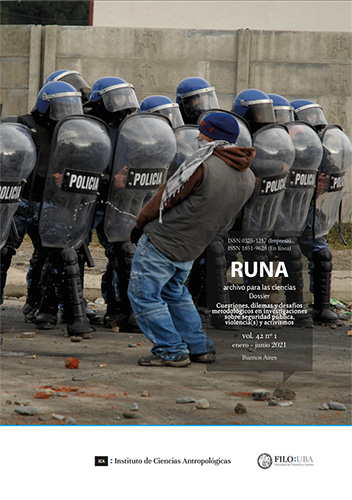
Cardozo, Darío Gonzalo, Cristina Beatriz Dejean, María Gabriela Russo, Bárbara Mazza, Daniel Loponte, Alejandro Acosta, María Rosario Feuillet, Silvia Cornero, Livia Kozameh, and Alicia Haydeé Tapia. 2021. “Impacto de la conquista hispánica en el Humedal del Paraná Inferior (Argentina) Una perspectiva histórica y genética mitocondrial (Impact of the hispanic conquest at the lower Parana wetland (Argentina). An historical and mitochondrial genetic perspective)”. RUNA, archivo para las ciencias del hombre 42(1): 409-433.
Para indagar sobre el impacto genético que habría generado la conquista hispánica en los grupos nativos asentados en el Paraná medio e inferior se analizaron muestras de individuos pre y poshispánicos de la región. Se identificaron los haplogrupos de ADN mitocondrial empleando polimorfismos de longitud de fragmentos de restricción (RFLP). Los datos obtenidos se compararon con los de otros sitios arqueológicos pre y poshispánicos y con muestras contemporáneas. Se observó mayor prevalencia del haplogrupo nativo B en las muestras poshispánicas, aunque sin diferenciación significativa con el grupo prehispánico de la región del Paraná medio e inferior. Ambos grupos presentan frecuencias de haplogrupos similares a muestras modernas provenientes del Gran Chaco y la provincia de Córdoba. Esto se corresponde con datos arqueológicos y de fuentes documentales de la reducción de Santiago del Baradero (provincia de Buenos Aires), con la prohibición de la salida de mujeres de la reducción y la escasez de individuos foráneos.
In order to investigate the genetic impact that the Hispanic conquest would have generated in the native groups settled in the Middle and Lower Paraná, samples of pre and post-Hispanic individuals of this region were analyzed. Mitochondrial DNA haplogroups were identified using restriction fragment length polymorphism (RFLP). The data were compared with those from other pre- and post-Hispanic archaeological sites and with contemporary samples. We observed a higher prevalence of native B haplogroup, in the post-Hispanic samples, without significant difference with the pre-hispanic group of the lower and middle Parana region. Both groups present similar haplogroup frequencies of those found in samples from Gran Chaco and the Córdoba province. This corresponds with archaeological data and the documentary sources about the Santiago del Baradero reduction (Buenos Aires province), with the prohibition of the departure of women from the reduction and the shortage of foreigners
Para investigar o impacto genético que a conquista hispânica teria gerado nos grupos nativos assentados no Médio e Baixo Paraná, amostras de indivíduos pré e pós-hispânicos da região foram analisadas. Os haplogrupos de DNA mitocondrial foram identificados usando polimorfismos de comprimento de fragmento de restrição (RFLP). Os dados obtidos foram comparados com os de outros sítios arqueológicos pré e pós-hispânicos e com amostras contemporâneas. Uma maior prevalência do haplogrupo B nativo foi observada nas amostras pós-hispânicas, embora sem diferenciação significativa em relação ao grupo pré-hispânico da região do Médio e Baixo Paraná. Ambos grupos apresentam freqüências semelhantes de haplogrupos que aquelas amostras modernas do Gran Chaco e da província de Córdoba. Isto se correlaciona con os dados arqueológicos y de fontes documentais sobre a redução em Santiago del Baradero (província de Buenos Aires), com a proibição de mulheres para sair da redução e a escassez de indivíduos estrangeiros.

Crumbley, Deidre H.. 2021. “How a Coerced Confession Shaped a Family History”. Sapiens.

Bandiera, Michele and Enrico Milazzo. 2021. "Visceral Ecologies in the Borderland: Soils and Care from Olive Tress' Hecatomb in Salento". Sites: A Journal of Social Anthropology and Cultural Studies 18(2): 48-72.
This contribution focuses on soils and care as fundamental matters of inquiry, in order to retrace the processes determining the resurging possibilities of Salento’s landscape. The South-East Italian territory is plagued by an epidemic of Xylella fastidiosa, a bacterium which has killed hundreds of thousands of olive-trees. We untangle the ecology of the olive trees’ depletion, taking into consideration the most recent scientific research on the main vector of the bacteria, the little spittlebug Philaenus spumarius. We describe the quality of these relationships that entangle multispecies assemblies as ‘visceral ecology’ and explore it by interlacing the vector’s ecology and the dying olive trees with a local oil miller’s intestinal disease. Framing the soil of Salento as an ‘open air intestine’ allows us to merge materialist views and practices of care with the ecosystem’s transformations. In conclusion, we argue for the interconnectedness of materialism and care in shaping both the imaginary and the material conditions for future local human-landscape relations.
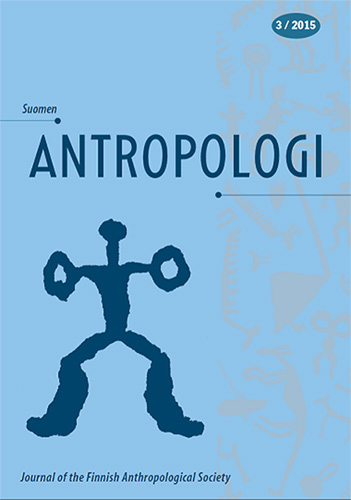
Lounela, Anu. 2021. “Making and Unmaking Territories with Plants in the Riverine Peat Landscape of Central Kalimantan”. Suomen antropologi: Journal of the Finnish Anthropological Society 46(1): 15–37.
Central Kalimantan, located on the Indonesian side of Borneo, has often been described as a state frontier area where rapid changes take place in legal and administrative regimes and in the rules that govern access and ownership to land and nature. Today, frontier development includes state and non-state actors that bring natural resource projects aimed at producing long-term effects by engaging local people in the commodification of nature. Local people adopt and abandon these projects at a rapid pace due to changing conditions, policies, and natural hazards. I will explore commodification in terms of territorial projects and the spatial and temporal reordering of human-nature relations within the landscapes of Central Kalimantan. Linked to the territorial expansion of trees and plants, commodification challenges local environmental practices and forms of sociality. The paper argues that the commodification of nature and the territorial aspects of this bring new layers of complications and thus have unexpected effects on the lives of local populations.
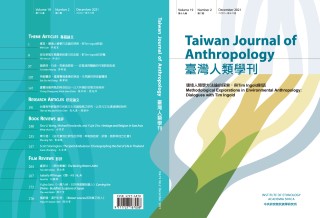
林益仁 (Lin, Yih-ren). 2021. “我在泰雅生態農耕敘事中的走動:對Tim Ingold的呼應 (My Walking in the Tayal Agro-Ecological Narratives: Corresponding with Tim Ingold)”. 臺灣人類學刊 (Taiwan Journal of Anthropology) 19(2): 9-56.
本文是2016-2019這三年我參與科技部「人文創新與社會實踐計畫」研究與課程發展經驗的反思敘事,內容是探討新竹縣尖石鄉後山泰雅人農耕生態知識的內涵與實踐。本文受到人類學者TimIngold關於走動(walking)概念的啟發極大。此外,透過他對生產(production)、歷史(history)、所在(dwelling)、與路線(lines)的概念詮釋,勾勒出我在泰雅家園走動思維的內涵,並據此提出一種對照顧(care)的生態新解,且跟他在概念上進行呼應(corresponding)。在當代,泰雅人農耕的活動越來越被吸納到現代的市場經濟邏輯底下時,原先維繫傳統家園運作的連結也開始鬆動與改變。經由田野蹲點與參與式課程的走動,我觀察到這些維繫家園的元素其實都還存在著,而且用當代的方式開展著。本文透過敘事的方法凸顯這些元素的重要性,並指出它的核心乃在於體認到幫助它者成長的關鍵道理。本文分成五大部分:第一部分為前言,勾勒出本文對於走動的探問;第二部分提出敘事的方法論,強調走動以及敘事(narrative)的互補作用;第三部份用四段敘事來闡述我對於課程走動中所紀錄的泰雅人農耕活動,並對於傳統生態知識的概念進行反省;第四部分則是與TimIngold在以生命為何的主軸思考下的對話;第五部分是結論,提出照顧概念的生態新解,以此作為對Ingold論述生命的人類學思維的回饋,用他的話來說即是呼應(corresponding)。
This paper is a reflective narrative depicting the characteristics and practices of the traditional agricultural ecological knowledge of the Tayal people who live in the hind mountains of Jienshi District, Hsinchu County. This paper also initiates a dialogue with anthropologist Tim Ingold’s discourse about walking based on his interpretations of the concepts of production, history, dwelling and lines, which I echo with my understanding of care from an ecological perspective. In contemporary society, Tayal people’s agricultural activities are greatly influenced by the modern market economy. Therefore, the operation of traditional household management is loosened and changed. However, through my fieldwork and action-oriented teaching courses in the university, I found that some elements from their traditional knowledge practices still exist and borrow a modern form to develop. This paper employs the methodology of narrative enquiry to highlight the importance of these elements. Furthermore, my research indicates that the core spirit of these traditional knowledge practices lies in recognizing ways to help others to grow. The paper is divided into five parts. The first part is an enquiry into the concept of “walking.” The second part uses the method of narrative to bring out the complementary relationship between walking and narrative. The third part uses four narratives to illustrate Tayal people’s agricultural stories and related reflections. The fourth part engages in a dialogue with Tim Ingold’s anthropology of life. Finally, an ecological interpretation of care is provided as a correspondence to Ingold’s thought.

Cornago, Damián Bentos. 2021. “Territorios compartidos: el caso de la migración neorrural en la zona de Aiguá en Uruguay”. Trama 12: 34-44.
La neorruralidad surge en la década de 1960 como un fenómeno migratorio de habitantes urbanos que se trasladan a zo-nas rurales en busca, principalmente, de un mayor contacto con la naturaleza, a la vez que intentan dejar atrás los tiempos, las exigencias y problemáticas citadinas. De acuerdo con un estudio de caso en la localidad de Aiguá y sus sierras circun-dantes, al sudeste de Uruguay, en el pre-sente artículo se expone y analiza cómo impacta la llegada de estos nuevos habi-tantes a las zonas rurales en cuanto al vínculo con la población nativa. La con-fluencia de culturas, una urbana y otra pueblerina o rural, genera encuentros, desencuentros y formas de existencias paralelas, siendo en ocasiones lenta la asimilación de los recién llegados.
Neo-rurality emerged in the 1960s as a mi-gratory phenomenon of urban inhabitants who moved to rural areas in search mainly of greater contact with nature, while trying to leave behind the times, demands and problems of the city. Based on a case study in the town of Aiguá and its sur-rounding hills, in the southeast of Uru-guay, this article presents and analyzes how the arrival of these new inhabitants to rural areas impacts on the interaction with the native population. The confluence of cultures, one urban and the other “village” or rural, generates encounters, disagree-ments and forms of parallel existence, with the assimilation of newcomers being slow at times.
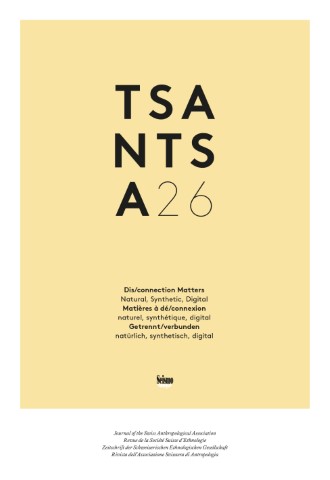
Silva Garzón, Diego. 2021. “From Standard to Region-Specific Monocrops: Localizing Industrial Agriculture through Microbes’ Taste of Place”.TSANTSA – Journal of the Swiss Anthropological Association 26:18-36.
Industrial agriculture has promoted the expansion of monocrops around the world, aided by the circulation of highly standardized plant varieties. However, given the adverse environmental effects of this agricultural approach (such as genetic erosion) and the challenges posed by climate change, some biotech companies are trying to complexify industrial agriculture’s relationship to “place”. They are beginning to consider local particularities in the design of seed products. Focusing on the experience of an Argentinian biotech company, this article explores the creation of microbial seed treatments that claim to be “region-specific” and whose production is mediated by novel meta-genomic techniques. Through the notions of association and mediation, the article reflects on the diverse meanings of region-specificity (geographical, environmental, relational) that are mobilized in the creation of these products. In this way, the article highlights the role of computational technologies, plants, and microorganisms in the shaping of scientific and corporate meanings of place.

Sá Gonçalves, Renata de. 2021. “Walking through Rio de Janeiro’s ‘Little Africa’: places and contested borders”. Vibrant 18.
At the turn of the twenty-first century, the urban renewal project in Rio de Janeiro’s port region emphasized the macroscopic scale of road building and projects designed for the future. In parallel, the production of localities and cultural heritage have often sought to adapt to the impacts of urban transformation. Guided tours fostering the idea of ‘African heritage’ construct places of historical and contemporary significance, reinterpreting their wider connections with people and places and their disputed borders. In this context, ‘Little Africa’ involves the production of a ‘place’ designed locally by cultural associations that promote walking tours in an attempt to fix routes that either adapt to or subvert times and spaces.
Nesta virada do século XXI, o projeto de renovação urbana da região portuária do Rio de Janeiro enfatizou a escala macroscópica da abertura de vias e implementação para o futuro. Em paralelo, a produção de lugares e do patrimônio cultural procuraram algumas vezes acomodar os impactos da transformação urbana. As visitas guiadas voltadas para uma ideia de "herança africana" produzem lugares de significado histórico e contemporâneo, reinterpretando suas conexões mais amplas com as pessoas e com o local e suas fronteiras em disputa. Neste contexto, a "Pequena África" como a produção de um "lugar" se desenha localmente por associações culturais que promovem seus roteiros guiados na tentativa de fixação de caminhos que ora acomodam, ora subvertem tempos e espaços.
